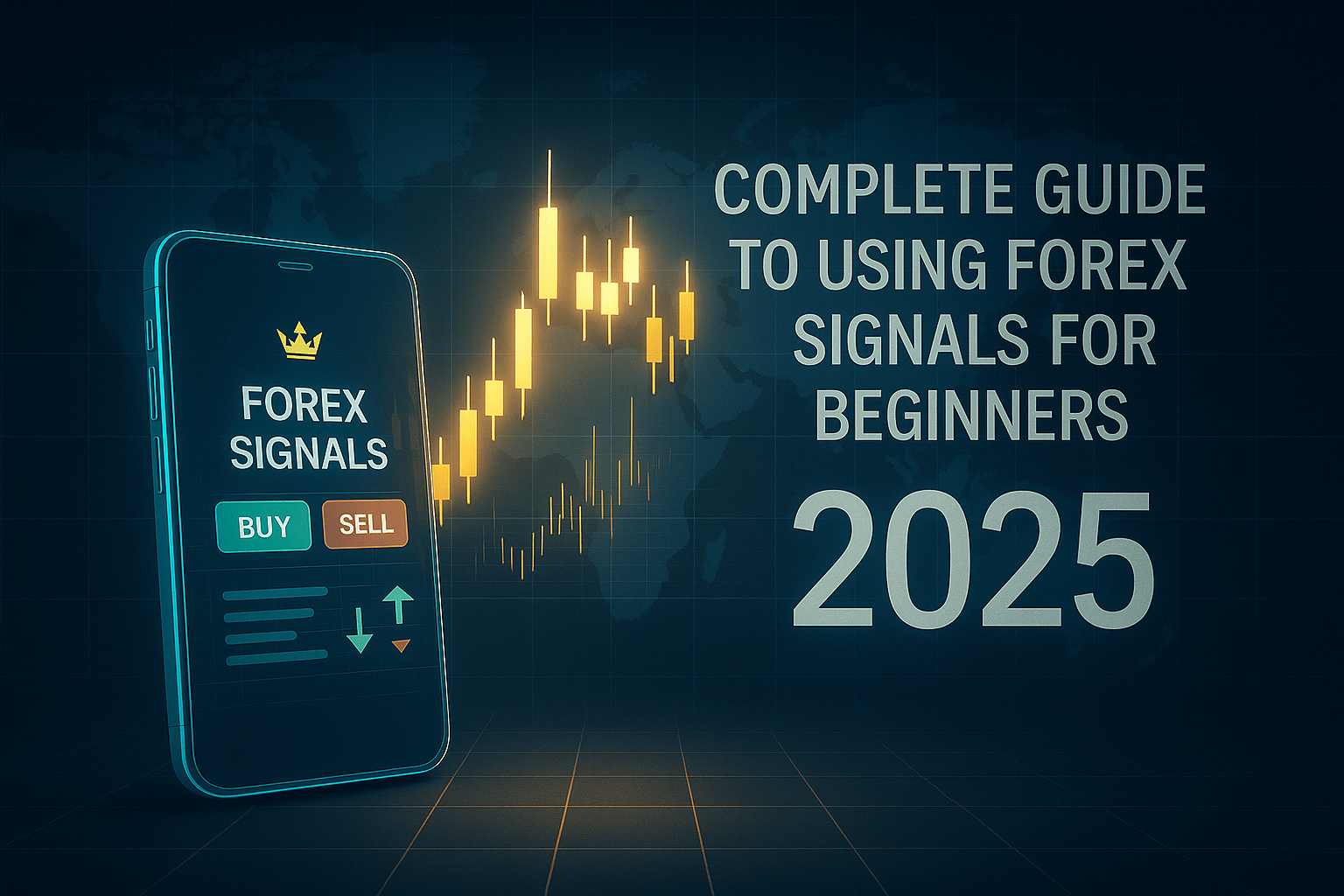Starting your forex trading journey can feel overwhelming, especially when faced with complex charts, economic indicators, and volatile markets. That’s where forex signals come in – they’re like having an experienced trader guiding your decisions. This comprehensive guide will teach you exactly how to use forex signals effectively, avoid costly mistakes, and build a profitable trading strategy as a beginner.
Whether you’re completely new to trading or have dabbled without success, understanding forex signals for beginners is crucial for navigating the $7.5 trillion daily forex market. By the end of this guide, you’ll know how to evaluate signals, implement them safely, and choose between free and premium services based on your goals.
What Are Forex Signals and How They Work
Forex signals are trade recommendations that tell you when to buy or sell a currency pair at a specific price and time. Think of them as GPS directions for trading – they guide you through the market’s complexities by providing:
- Entry Point: The exact price to open a trade
- Currency Pair: Which currencies to trade (EUR/USD, GBP/JPY, etc.)
- Direction: Whether to buy (go long) or sell (go short)
- Stop Loss: Where to exit if the trade goes against you
- Take Profit: Your target price for closing the trade profitably
- Risk/Reward Ratio: How much you’re risking versus potential profit
Types of Forex Signals
Manual Signals: Created by professional traders who analyze the market using technical indicators, fundamental analysis, and years of experience. These signals often come with detailed explanations of the trading rationale. Manual signals typically provide better context for market conditions.
Automated Signals: Generated by algorithms and trading robots that scan markets 24/7 for opportunities based on predefined criteria. While faster, they may miss nuanced market conditions that human traders catch. Blueberry Markets notes that automated signals work best in trending markets.
Copy Trading Signals: Automatically replicate trades from successful traders in real-time. Popular on platforms like eToro, these require less active management but still need careful provider selection.
How Signals Are Delivered
Modern forex signals reach traders through various channels:
- Telegram Channels: Most popular due to instant notifications and ease of use
- Email Alerts: Traditional but may have slight delays
- SMS Messages: Direct but limited in detail
- Trading Platform Integration: Automatic execution capabilities
- Mobile Apps: Dedicated applications with push notifications
Step-by-Step Process for Following Signals
Successfully using forex signals requires a systematic approach. Here’s your roadmap to getting started:
Step 1: Set Up Your Trading Environment
Before receiving your first signal, ensure you have:
- A funded trading account with a regulated broker
- The Telegram app (or preferred signal delivery method) installed
- A demo account for initial practice
- Basic understanding of order types (market, limit, stop)
Step 2: Configure Your Risk Parameters
Never risk more than 1-2% of your account per trade. If you have $1,000, each trade should risk $10-20 maximum. This protects your capital during losing streaks. BabyPips offers an excellent free course on position sizing.
Calculate your position size using this formula:
Position Size = (Account Risk %) × (Account Balance) ÷ (Stop Loss in Pips × Pip Value)For easy calculations, use a position size calculator to ensure accuracy.
Step 3: Receive and Analyze the Signal
When a signal arrives, don’t rush. A typical signal looks like this:
🔥 FOREX SIGNAL 🔥
Pair: EUR/USD
Action: BUY
Entry: 1.0850
Stop Loss: 1.0820 (30 pips)
Take Profit 1: 1.0880 (30 pips)
Take Profit 2: 1.0910 (60 pips)
Risk/Reward: 1:2Step 4: Verify Market Conditions
Before executing:
- Check if the entry price is still valid
- Ensure no major news events are imminent
- Confirm the signal aligns with overall market trend
Step 5: Execute the Trade
Enter your position exactly as specified:
- Open your trading platform
- Select the currency pair
- Input the position size you calculated
- Set stop loss and take profit levels
- Confirm and submit the order
Step 6: Manage the Position
Once in the trade:
- Don’t move your stop loss to increase risk
- Consider taking partial profits at TP1
- Follow any updates from your signal provider
- Record the trade outcome for analysis
Common Mistakes Beginners Make
Learning from others’ errors can save you thousands of dollars. Here are the most costly mistakes beginners make with forex signals:
1. Overleveraging Positions
The Mistake: Using maximum leverage because signals seem “guaranteed” The Fix: Stick to 1:10 or 1:20 leverage initially, regardless of signal confidence
2. Ignoring Risk Management
The Mistake: Risking 10-20% per trade hoping for quick profits The Fix: Never exceed 2% risk per trade, even on “sure winners”
3. Signal Shopping
The Mistake: Jumping between providers after a few losses The Fix: Commit to one provider for at least 30 days to evaluate properly
4. Emotional Trading
The Mistake: Closing trades early from fear or holding losers hoping for reversal The Fix: Set your levels and walk away – let the trade play out
5. Not Keeping Records
The Mistake: Failing to track performance and learn from results The Fix: Use a trading journal to record every trade. TradingView also offers excellent charting tools for analysis.
6. Following Too Many Signals
The Mistake: Taking every signal from multiple providers simultaneously The Fix: Focus on quality over quantity – 3-5 good trades weekly beats 20 mediocre ones. DailyFX recommends limiting yourself to one provider initially.
How to Evaluate Signal Quality and Provider Credibility
Not all signal providers are created equal. The forex signals industry unfortunately attracts scammers promising unrealistic returns. Here’s how to separate legitimate providers from fraudsters:
Performance Metrics That Matter
Win Rate: Look for 60-70% accuracy. Anything above 80% is likely fabricated. Sustainable signal providers maintain realistic win rates with proper risk management.
Risk/Reward Ratio: Professional providers target at least 1:1.5, meaning potential profits exceed potential losses. Benzinga’s educational guide shows that successful providers focus on risk-adjusted returns.
Maximum Drawdown: Quality providers limit drawdowns to 20-30% of account equity. Deeper drawdowns indicate poor risk management. Industry standards recommend avoiding providers with drawdowns exceeding 35%.
Track Record Duration: Demand at least 6-12 months of verified results. Short-term results can be luck or carefully selected periods.
Red Flags to Avoid
- Guaranteed Profits: No legitimate provider guarantees returns
- Photoshopped Results: Always verify through third-party tracking
- Pressure Tactics: Urgent “limited time” offers are usually scams
- No Trial Period: Reputable providers offer trials or money-back guarantees
- Hidden Costs: Beware of providers requiring specific broker affiliations
Verification Methods
- Third-Party Tracking: Services like Myfxbook or FX Blue provide independent verification
- Live Trading Results: Demand real account results, not backtests or demos
- Community Reviews: Check Forex Peace Army and Trustpilot for unbiased user reviews
- Regulatory Compliance: Ensure providers comply with local financial regulations. CFTC offers guidance on avoiding forex scams.
Risk Management When Using Signals
Proper risk management transforms forex signals from gambling into strategic investing. Here’s your comprehensive risk framework:
Position Sizing Strategy
The 2% rule remains the gold standard according to risk management experts. HowToTrade’s educational resources explain this principle in detail:
- Risk maximum 2% per trade
- Reduce to 1% during losing streaks
- Never exceed 6% total exposure across all open trades
Investopedia’s risk management guide reinforces these principles for sustainable trading.
Diversification Principles
Currency Correlation: Avoid trading highly correlated pairs simultaneously (EUR/USD and GBP/USD often move together)
Time Diversification: Spread trades across different sessions and days
Strategy Mix: Combine trend-following and range-trading signals
Stop Loss Management
- Never trade without a stop loss – it’s your insurance policy
- Place stops beyond key support/resistance levels
- Use trailing stops to protect profits in winning trades
- Don’t move stops further from entry to “give trades room”
Psychological Risk Control
- Set daily/weekly loss limits
- Take breaks after consecutive losses
- Don’t revenge trade to recover losses
- Maintain a trading journal for emotional patterns
Account Protection Rules
- Maximum Daily Loss: Stop trading after losing 5% in one day
- Correlation Limits: No more than 3 correlated positions
- News Trading: Avoid signals during high-impact news events
- Weekend Protection: Close or reduce positions before weekends
Choosing Between Free and Premium Services
The decision between free and premium forex signals significantly impacts your trading journey. Let’s examine both options objectively:
Free Forex Signals
Advantages:
- No financial commitment required
- Good for learning signal structure
- Test trading discipline without cost
- Access to basic market insights
Disadvantages:
- Often delayed or less detailed
- Limited support and education
- Higher risk of abandonware
- May push broker affiliations aggressively
Best For: Complete beginners testing the waters or traders with very small accounts under $500
Premium Forex Signals
Advantages:
- Professional analysis and research
- Timely delivery and updates
- Educational content and support
- Verified track records
- Better risk/reward ratios
- Account management guidance
Disadvantages:
- Monthly costs ($50-300 typically)
- Pressure to trade more for value
- Some providers overpromise results
Best For: Traders with $1,000+ accounts serious about consistent profits
Making the Right Choice
According to comprehensive research in the industry, successful signal following requires:
- Account Size Consideration: Premium signals need $1,000+ to justify costs
- Time Commitment: Free signals require more personal analysis
- Learning Goals: Premium often includes valuable education
- Risk Tolerance: Free signals may have looser risk management
Industry experts suggest that beginners start with free signals to understand the process before committing to premium services. Investopedia’s guide to forex trading emphasizes the importance of education before paid services.
Evaluation Framework
Before choosing any service:
- Try free trials or money-back guarantees
- Calculate break-even pip requirements
- Assess educational value beyond signals
- Verify provider transparency and support
Getting Started with United Kings Signals
Now that you understand how forex signals work, it’s time to put knowledge into practice. United Kings offers both free daily signals and comprehensive VIP memberships designed specifically for beginners through advanced traders.
Why Beginners Choose United Kings
- Educational Focus: Every signal includes market analysis explanation
- Realistic Expectations: 65-75% win rate with proper risk management
- 24/7 Support: Dedicated team assists with signal implementation
- Flexible Plans: From free trials to full VIP access
- Multi-Market Coverage: Forex, crypto, and commodities signals
Your Next Steps
- Start with Free Signals: Test our methodology without risk
- Practice on Demo: Implement signals on demo accounts first
- Scale Gradually: Begin with mini lots when going live
- Track Everything: Use our provided tracking spreadsheet
- Engage with Community: Learn from other members’ experiences
Conclusion
Mastering how to use forex signals as a beginner requires patience, discipline, and the right guidance. By following this comprehensive guide, you’ve learned the fundamental steps to evaluate providers, implement signals safely, and manage risks effectively.
Remember, forex signals for beginners are tools, not magic formulas. Success comes from combining quality signals with proper risk management, continuous learning, and emotional discipline. Whether you choose free or premium services, start small, track your results, and scale gradually as your confidence and account grow.
The forex market offers incredible opportunities for those who approach it professionally. With the right signals and this guide’s framework, you’re ready to begin your trading journey on solid ground.
Ready to receive your first professional forex signal? Join thousands of successful traders using United Kings signals. Start with our free signals to experience the difference quality analysis makes, then upgrade to VIP when you’re ready for accelerated growth. [Get Started Today →]




